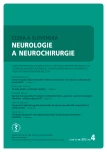An Association between Neonatal Jaundice and Autism
Authors:
H. Ošlejšková 1; K. Kubíčková 2
; J. Foglová 2; P. Hanáková 1; Z. Makovská 1; T. Pavlík 4; Z. Doležel 3
Authors‘ workplace:
Klinika dětské neurologie LF MU a FN Brno, Centrum pro epileptologii a epileptochirurgii LF MU, Brno
1; LF MU, Brno
2; Pediatrická klinika LF MU a FN Brno
3; Institut biostatistiky a analýz LF MU, Brno
4
Published in:
Cesk Slov Neurol N 2012; 75/108(4): 472-476
Category:
Short Communication
Overview
Introduction:
Autistic Spectrum Disorders (ASD) include neurodevelopmental disorders characterized by impaired social interaction, communication and stereotyped patterns of behaviour and interests. The aetiology of autism is not fully understood, although both genetic and non-genetic factors are believed to be involved. Pathological neonatal jaundice (PNI) has been considered as a potential cause.
Aim of study:
The main aim of this study was to determine an association between PNI and autism in full-term and preterm infants.
Material and methods:
A retrospective case-control study was performed at the Department of Paediatric Neurology and Department of Paediatric Internal Medicine in Brno. The subjects were 328 patients, who had been diagnosed with ASD between 1999 and 2011. Medical records of 402 gender- and age-matched controls without the diagnosis of autism who were examined at the Department of Paediatric Internal Medicine, were also reviewed.
Results:
The autistic group had noticeable PNI in 17.1% (49/287) full-term infants and 29.3% (12/41) preterm infants. The control group had PNI in 9.5% (35/367) full-term infants and 45.7% (16/35) preterm infants. There was a statistically significant association between neonatal jaundice and autism in full-term infants (OR = 1.95, 95% CI 1.23–3.10, p = 0.005). The association between neonatal jaundice and autism in preterm infants was not confirmed (OR = 0.49; 95% CI 0.25–1.33; p = 0.255).
Conclusion:
The study is the first to describe the association between PNI and autism in the Czech Republic and further studies will be necessary to confirm the results.
Key words:
autism – pathological neonatal jaundice – physiological neonatal jaundice – hyperbilirubinemia
Sources
1. Rapin I, Tuchman R. Where we are: overview and definitions. In: Tuchman R, Rapin I (eds). Autism: a neurological disorder of early brain development. London: Mac Keith Press 2006: 1–18.
2. Anagnostou E, Schevell M. Outcomes of children with autism. In: Tuchman R, Rapin I (eds). Autism: a neurological disorder of early brain development. London: Mac Keith Press 2006: 308–321.
3. Fombonne E. Epidemiology of pervasive developmental disorders. Pediatr Res 2009; 65(6):
591–598.
4. Howlin P, Goode S, Hutton J, Rutter M. Adult outcome for children with autism. J Child Psychol Psychiatry 2004; 45(2): 212–229.
5. Howlin P. Outcomes in autism spectrum disorders. In: Volkmar FR, Paul R, Klin A, Cohen D (eds). Handbook of autism and pervasive developmental disorders. 3rd ed. New Jersey: John Wiley & Sons Ltd. 2005: 201–222.
6. Mezinárodní klasifikace nemocí. Duševní poruchy a poruchy chování. Popisy klinických příznaků a diagnostická vodítka. 10. revize. Praha: Psychiatrické centrum 1992.
7. Abrahams BS, Geschwind DH. Advances in autism genetics: on the threshold of a new neurobiology. Nat Rev Genet 2008; 9(5): 341–355.
8. Muhle R, Trentacoste SV, Rapin I. The genetics of autism. Pediatrics 2004; 113(5): 472–486.
9. Mehler MF. Epigenetics and the nervous system. Ann Neurol 2008; 64(6): 602–617.
10. Daniels JL. Autism and the environment. Environ Health Perspect 2006; 114(7): A396.
11. Maimburg RD, Bech BH, Vaeth M, Møller-Madsen B,
Olsen J. Neonatal jaundice, autism, and other disorders of psychological development. Pediatrics 2010; 126(5): 872–878.
12. Maimburg RD, Bech BH, Vaeth M, Schendel DE, Olsen J, Thorsen P. Neonatal jaundice: a risk factor for infantile autism? Paediatr Perinat Epidemiol 2008; 22(6): 562–568.
13. Hrodek O, Vavřinec J. Pediatrie. Praha: Galén 2002: 67–88.
14. Zibolen M, Zbojan J, Dluholucký S. Praktická neonatológia. Martin: Neografia 2001: 178–188.
15. Hrdlicka M. Structural neuroimaging in autism. Neuroendocrinol Lett 2008; 29(3): 281–286.
16. Croen LA, Yoshida CK, Odouli R, Newman TB. Neonatal hyperbilirubinemia and risk of autism spectrum disorders. Pediatrics 2005; 115(2): e135–e138.
17. Amin SB, Smith T, Wang. Is neonatal jaundice associated with autism spectrum disorders: a systematic review. J Autism Dev Disord 2011; 41(11):
1455–1463.
18. Zwinger A et al. Porodnictví. Praha: Galén 2004: 77–119.
19. Zar J. H. Biostatistical Analysis. 5th ed. New Jersey: Pearson Prentice-Hall 2010.
20. Buchmayer S, Johansson S, Johansson A, Hultman CM, Sparen S, Cnattingius S. Can association between preterm birth and autism be explained by maternal or neonatal morbidity? Pediatrics 2009; 124(5): e817–e825.
21. American Psychiatric Association. Diagnostic and statistical manual of mental disorders, 4th ed. Washington, DC: American Psychiatric Association 1994.
22. Brown AK, Johnson L. Loss of concern about jaundice and the reemergence of kernicterus in full term infants in the era of managed care. In: Fanaroff AA, Klaus M (eds). Yearbook of Neonatal and Perinatal Medicine. St Louis, Mosby Yearbook; 1996: 17–28.
23. Stephens BE, Vohr BR. Neurodevelopmental outcome of the premature infant. Pediatr Clin North Am 2009; 56(3): 631–646.
24. Ošlejšková H, Pejčochová J. Autizmy. Cesk Slov Neurol 2010; 73/106(6): 627–642.
Labels
Paediatric neurology Neurosurgery NeurologyArticle was published in
Czech and Slovak Neurology and Neurosurgery

2012 Issue 4
Most read in this issue
- Cerebral Arachnoid Cysts in Adults – Retrospective Analysis of the Results of Surgical Treatment
- Rhythmic Movement Disorder
- Isolated Sphenoid Sinusitis – Possible Cause of Headache and Severe Complications
- The Oswestry Questionnaire, Version 2.1a – Results in Patients with Lumbar Spinal Stenosis, Comparison with the Previous Version of the Questionnaire
